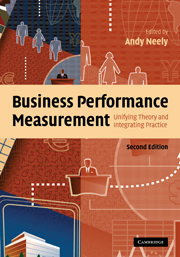Book contents
- Frontmatter
- Contents
- List of figures
- List of tables
- List of boxes
- List of contributors
- Introduction
- Part I Performance measurement – functional analyses and theoretical foundations
- Part II Performance measurement – frameworks and methodologies
- Part III Performance measurement – practicalities and challenges
- Part IV Performance measurement in public services
- 16 Measuring the performance of England's primary school teachers: purposes, theories, problems and tensions
- 17 Police performance: sovereignty, discipline and governmentality
- 18 The development of composite indicators to measure health care performance
- 19 Perversity in public service performance measurement
- Part V Performance measurement – emerging issues and enduring questions
- Index
- References
17 - Police performance: sovereignty, discipline and governmentality
Published online by Cambridge University Press: 22 September 2009
- Frontmatter
- Contents
- List of figures
- List of tables
- List of boxes
- List of contributors
- Introduction
- Part I Performance measurement – functional analyses and theoretical foundations
- Part II Performance measurement – frameworks and methodologies
- Part III Performance measurement – practicalities and challenges
- Part IV Performance measurement in public services
- 16 Measuring the performance of England's primary school teachers: purposes, theories, problems and tensions
- 17 Police performance: sovereignty, discipline and governmentality
- 18 The development of composite indicators to measure health care performance
- 19 Perversity in public service performance measurement
- Part V Performance measurement – emerging issues and enduring questions
- Index
- References
Summary
Introduction
This chapter considers performance measurement as a form of knowledge that is intimately connected with power. The setting for the study is the measurement of police performance and how performance measurement constitutes and is constituted by knowledge and power. The work of French philosopher Michel Foucault is used to understand how performance measurement has been a tool by which the sovereignty of government over policing has been established, and how performance measurement has been adopted as a disciplinary measure, such that both can be viewed as governmental technologies involving the use of power to constitute knowledge deemed to be important for political purposes.
The context of policing
Policing in England and Wales (the “Home Office” forces) is carried out through forty-three relatively autonomous police forces. Governance of policing is tripartite, comprising the chief constables, a police authority for each force area and the Home Secretary. Chief constables (or commissioner in the case of the Metropolitan Police), as the professional head of each force, have independence from political interference in operational matters. Police authorities are responsible for setting the force budget, determining local priorities and holding chief constables accountable for their performance. The Home Secretary is responsible for the efficiency and effectiveness of policing nationally.
- Type
- Chapter
- Information
- Business Performance MeasurementUnifying Theory and Integrating Practice, pp. 363 - 382Publisher: Cambridge University PressPrint publication year: 2007



